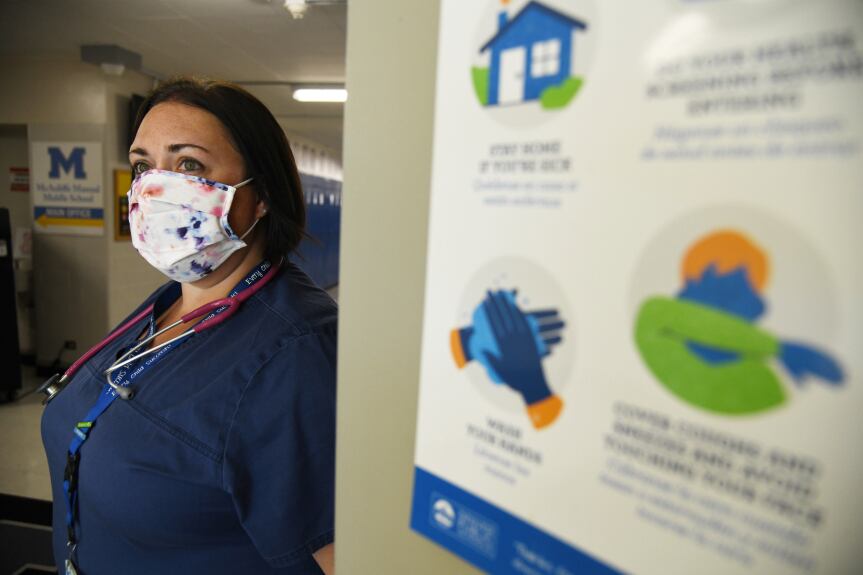Many Michigan school administrators say they’ve often served as stand-in public health officials during the pandemic. So it’s no surprise that districts across the state are eager to get some backup from a program that opens clinics in school buildings.
School-based health centers make it convenient for students to leave class and walk down the hall for therapy, a medical checkup, or a dental appointment. While the first centers in Michigan opened decades ago, policymakers have renewed interest in them in the wake of COVID and the ongoing student mental health crisis.
As advocates push for a major funding increase, the outcome of this year’s budget negotiations could shape Michigan’s system for supporting student mental health for years to come — even after federal COVID funds run out. It would mean new health centers in roughly 100 districts that have expressed an interest in opening one but weren’t awarded funds.
Rates of depression and suicide among Michigan youth were already rising when the pandemic hit. State and federal officials are now warning of an emergency in youth mental health. Yet one-third of Michigan students with a mental illness don’t receive treatment, particularly in rural areas.
Many school districts are trying to address that problem by putting more counselors, nurses, and social workers in schools with their share of federal COVID funds, according to a Chalkbeat analysis of spending plans. Adding new school-based health centers would make those efforts more effective, experts say, because the centers are better equipped to assist with the most complex cases, freeing up school staff to handle other needs.
Gov. Gretchen Whitmer wants the state to invest an additional $11 million to open new health centers in schools this year. A bipartisan group of lawmakers studying the Oxford shooting agree that more funding is needed, though they haven’t yet said how much. Advocates are pushing for even more: an additional $25 million this year, which would nearly double the state’s current investment in the centers.
Here’s what you need to know about school-based mental health centers.
What is a school-based health center?
The centers are formed under an agreement between local health care providers, such as a hospital system, a school district, and the state. All three parties share the costs.
Unlike a typical school nurse’s office, the centers are recognized by the government as health care providers, which means they can more easily provide referrals for care, and they can bill for services if students have insurance.
The school provides office space — often rent free — while the healthcare system provides medical workers such as licensed therapists and nurse practitioners. In some cases, a school nurse will share the space with health system employees.
If students have health insurance, the center can bill their insurer. If not, grants from the state help cover the cost of care, or the center can bill Medicaid. Students never have to pay out of pocket.
“The centers eliminate barriers of transportation and cost,” said Kim Baron, director of health services for Grand Rapids Public Schools. She also noted that students who get medical care in their school building don’t miss as much school as they would if they left during the day for a doctor’s appointment.
Why are school-based health centers getting so much attention now?
The first school-based health centers in Michigan opened in the 1980s, and their funding increased slowly but steadily for decades.
There are 124 centers across Michigan, with one in nearly half of the state’s 83 counties, according to the School-Community Health Alliance of Michigan, a nonprofit advocacy group.
The pandemic spotlighted the strengths of school-based health centers, said Deb Brinson, executive director of the School Community Health Alliance, which is pushing for a major new funding expansion to serve more students.
The centers stayed open even when many schools closed their doors, Brinson said. They offered medical expertise and infrastructure at a time when many school administrators were struggling to coordinate their community’s public health response. In many cases, the centers offered COVID testing and vaccinations.
As administrators across the state saw what the centers could do, “We started getting calls: How do we get a school based health center?” Brinson recalled.
Funding shot up last year, with an additional $5 million for mental health services. Now Whitmer is proposing an even larger increase.
Whitmer and legislative leaders will consider funding for the centers as part of this year’s budget negotiations, which will take place over the next few months.
Do the centers make a difference?
Students who used school-based mental health centers reported less risky behavior, better emotional coping strategies, and reduced physical stress, according to a 2018 study.
Various national studies have come to similar conclusions. A study of 168 schools in Oregon found that students at schools with health centers were less likely to report depression and suicide attempts.
Administrators in districts with centers say they are effective.
“There are hundreds of kids walking down the hall and getting the care that they need from a medical, dental, and behavioral health aspect,” said Tom Livezey, superintendent of Oak Ridge Public Schools near Muskegon.
“I can’t imagine having to go through the pandemic without this service.”
Before the pandemic, the Oakridge school health center typically served more than 700 unique students per year, including more than 1,000 mental health appointments. The district enrolls roughly 1,900 students.
How do the centers support mental health?
School-based health centers in Michigan are required to have a mental health staff person on site in addition to a medical professional such as a nurse.
Students can attend therapy or seek help if they are having an emotional crisis.
“From a mental health standpoint, we’re seeing kids act out in classrooms, and the anger and anxiety can turn into physical altercations in the schools,” Livezey said.
Given the lack of mental health providers for young people in the surrounding community, Livezey says school-based mental health centers are “the only way our kids are going to get adequate care.”
Koby Levin is a reporter for Chalkbeat Detroit covering K-12 schools and early childhood education. Contact Koby at klevin@chalkbeat.org.








